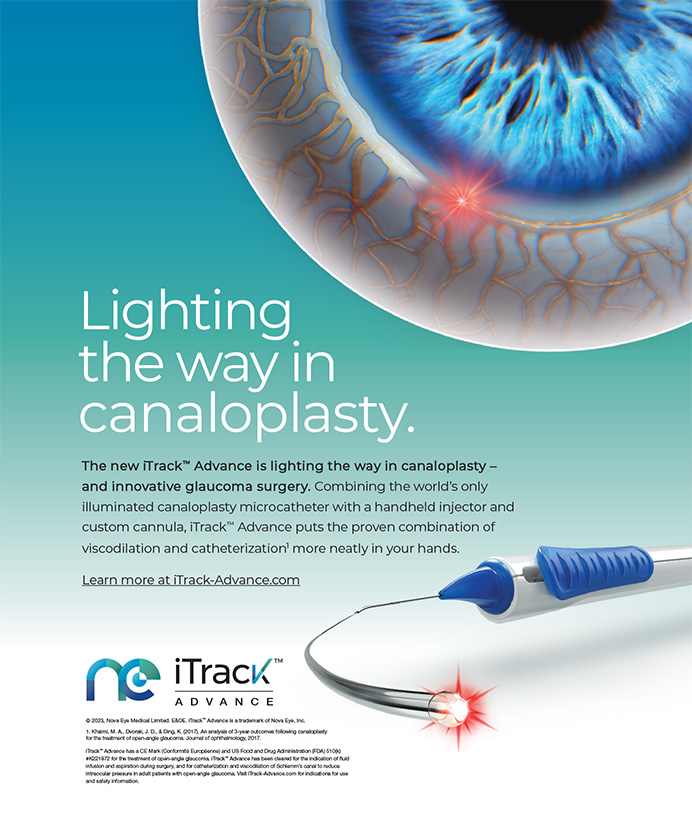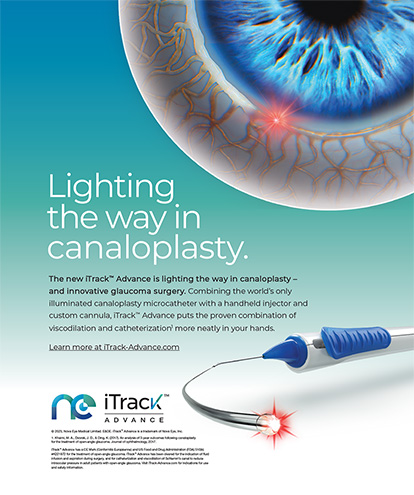The Case for a Lens-Based Approach
By William F. Wiley, MD

Hyperopic LASIK has historically been viewed as a revolutionary refractive procedure for farsighted individuals. Its approval for the treatment of higher degrees of hyperopia, however, does not necessarily imply universal applicability. As newer alternatives emerge, the limitations of hyperopic LASIK—outlined in this article—become increasingly apparent.
CHALLENGES WITH HYPEROPIC LASIK
High rate of enhancement. Hyperopic LASIK has a high enhancement rate of up to 20% within 12 months, primarily attributed to epithelial remodeling.1,2 As the epithelium fills the treatment zone, the artificially steepened cornea can normalize and leads to functional regression and possible reintroduction of the original visual impairment. This can require subsequent procedures even years after the initial surgery, often precluding the option of a flap lift. Moreover, performing hyperopic PRK over previous hyperopic LASIK presents challenges related to the treatment’s accuracy and predictability.
Quality of vision. The mechanism of hyperopic LASIK involves central corneal steepening. This raises both theoretical and practical concerns. Decentration can occur, affecting the alignment and positioning of the reshaped area, which can lead to a loss of contrast sensitivity and visual acuity and a compromise in vision quality.
Age-related refractive changes. Aging naturally diminishes accommodative capacity, leading to increased hyperopia. Consequently, hyperopic LASIK faces the inherent challenge of addressing a condition that evolves over time. Furthermore, the postoperative healing process after laser vision correction often exacerbates hyperopia. This contrasts with myopic LASIK, which benefits from a synchronous relationship between the natural age-related reduction in myopia and the treatment’s healing dynamics, which may also regress over time. The healing trends after myopic LASIK therefore align with the aging process, preserving vision quality.
THE RISE OF IOL TECHNOLOGY
Lens replacement surgery is an increasingly attractive option for individuals with hyperopia. The evolution of IOL technology now more than ever offers a compelling alternative to hyperopic LASIK. Trifocal IOLs are particularly noteworthy. These lenses can provide patients with clear distance, intermediate, and near vision (see the sidebar). Moreover, the risk associated with hyperopic clear lens surgery is generally lower than with myopic clear lens surgery because the latter poses risks such as retinal detachment.
It is essential to contextualize hyperopia; one must consider the Prince rule, which holds that most hyperopic corrections do not manifest clinically until the patient loses significant natural accommodation. This delay in presentation suggests that hyperopia, at its core, is intrinsically linked to dysfunctional lens syndrome. Instead of focusing merely on corneal modifications, a comprehensive approach should recognize that the root of the pathology resides in the lens. Therefore, lens-based interventions offer a more targeted and effective remedy for such patients.
Another key consideration is future lens surgery. Hyperopic LASIK can induce negative spherical aberrations in the cornea. Given that modern multifocal IOLs also exhibit these aberrations, combining the two modalities can adversely affect vision quality and contrast sensitivity.
THE BOTTOM LINE
Hyperopic LASIK remains an option, but the procedure’s inherent limitations and the emergence of advanced alternative treatments such as lens replacement surgery with trifocal IOLs underscore the need for a discerning approach.
1. Llovet F, Galal A, Benitez-del-Castillo JM, Ortega J, Martin C, Baviera J. One-year results of excimer laser in situ keratomileusis for hyperopia. J Cataract Refract Surg. 2009;35(7):1156-1165.
2. Reinstein DZ, Archer TJ, Gobbe M, Silverman RH, Coleman DJ. Epithelial thickness after hyperopic LASIK: three-dimensional display with Artemis very high-frequency digital ultrasound. J Refract Surg. 2010;26(8):555-564.
Phakic IOLs for Hyperopia
By Raymond Stein, MD, FRCSC

Several surgical options are available for treating hyperopia, including LASIK, PRK, refractive lens exchange (RLE), and phakic IOL implantation. The choice of procedure depends on the patient’s age, refractive error, corneal thickness, and corneal topography as well as the presence and degree of ocular surface disease and lenticular changes.
In Canada, where I practice, the Visian ICL (STAAR Surgical) is available for hyperopic correction in powers ranging from +3.00 to +10.00 D and 0.50 to 6.00 D of positive cylinder. This lens is my first choice for prepresbyopic patients with greater than 4.00 D of hyperopia and an anterior chamber depth of at least 3 mm.
LASIK, particularly when performed with a flying spot laser, can treat higher amounts of hyperopia. The risks of surgically induced dry eye disease, decreased quality of vision, and regression, however, are greater with LASIK than with a phakic IOL. Another consideration is eyes that would be steepened to beyond 48.00 D with LASIK. Therefore, prepresbyopic patients with relatively steep corneas may be best served with a hyperopic ICL to improve their acuity and comfort.
A third group of patients for whom I favor phakic IOL implantation includes those with great axial length and a history of radial keratotomy for treating high myopia. RLE can address their presbyopia, but phakic IOL implantation has a lower risk of retinal tears, early postoperative vitreous detachment, and retinal detachment because the crystalline lens is not removed.
Patients with keratoconus, pellucid marginal degeneration, or ectasia after laser vision correction who have stable corneas—usually after undergoing CXL—may be candidates for a phakic IOL. Candidates must attain satisfactory BSCVA preoperatively. Most of these patients are myopic rather than hyperopic, and laser vision correction could exacerbate their ectasia.
Phakic IOLs can also be used off-label as piggyback lenses. This strategy can be a safe and reasonable option if a patient experiences a significant hyperopic surprise following cataract surgery or RLE and an IOL exchange poses high complication risks.
Patients with presbyopia typically desire an improvement in both distance and near vision. I currently offer these individuals RLE with a multifocal IOL, extended depth of focus IOL, or Light Adjustable Lens (RxSight). If hyperopic phakic IOLs with extended depth of focus and other designs become available, the indications could expand greatly.
Hyperopic LASIK Is Still Relevant
By Shady T. Awwad, MD, and Wesam Silk, MD
Femto-LASIK Offers the Advantages of Natural Accommodation and Crystalline Lens Preservation
by Shady T. Awwad, MD

It has traditionally been more difficult to correct hyperopia than myopia with LASIK because of the broader angle kappa, elusive nature of latent hyperopia and accommodation, and unpredictable epithelial remodeling and biomechanical response in the peripheral ablation zone of a hyperopic cornea.1-3 Hyperopic excimer ablation, however, has advanced greatly during the past 2 decades. Flying spot lasers, radial compensation of the peripheral laser pulses, expanded optical zones, and centration on the corneal vertex rather than the pupil centroid have enhanced safety and efficacy.4-7 Femtosecond laser technology has also improved safety and predictability. The lasers’ ability to create thin, uniform, and broad flaps reduces regression, minimizes biomechanical alterations, and improves refractive predictability compared to mechanically created flaps.8 Current clinical results diverge markedly from the AAO’s 2004 report on the safety and efficacy of hyperopic LASIK.9
Research shows that what was previously considered to be postoperative hyperopic regression is partly due to untreated latent hyperopia. A study by de Ortueta and Mosquera demonstrated relative topographic refractive index stability between 3 months and 3 years following hyperopic LASIK.7 Hyperopic patients typically exhibit robust accommodative spasms, necessitating optimal pharmacologic relaxation of the ciliary muscles during initial evaluations to ensure precise treatment planning. A recent study indicated good corneal stability over 3 years in hyperopic eyes treated with femtosecond LASIK (femto-LASIK), as evidenced by consistent mean keratometry readings. These findings suggest reliable wound healing and minimal corneal regression.10
The decision between femto-LASIK and refractive lens exchange (RLE) for hyperopic eyes depends on several factors, including patient age and refractive error, target correction, and accommodative spasm.
TREATMENT RECOMMENDATIONS BASED ON PATIENT AGE
Patients less than 40 years of age. Femto-LASIK is a solid choice for individuals who are less than 40 years of age for the following reasons:
- It preserves the crystalline lens and retains the eye’s preoperative accommodative ability;
- The procedure is cost-effective, reversible, and adjustable;
- Its outcomes are predictable; and
- Patients’ postoperative recovery is faster than after RLE.
Provided that corneal thickness is adequate, I prefer femto-LASIK to PRK for this patient group because visual recovery after the latter procedure is slower. Any myopic shift may last up to and possibly beyond 6 months.11 PRK, moreover, can induce with-the-rule astigmatism if peripheral stromal haze develops nasally and temporally.11
Patients with hyperopia often experience a relaxation of accommodation as they age. An enhancement procedure can usually be performed after femto-LASIK when appropriate. Potential epithelial ingrowth from a flap relift can be mitigated with Nd:YAG laser treatment.12 Alternatively, PRK may be performed over the LASIK flap, especially if the refractive error to be corrected is low. RLE becomes a viable option if the hyperopic error is significant or accommodative spasms are pronounced.
Patients 40 to 60 years of age. Femto-LASIK blended vision is my preferred approach to patients with hyperopia who are 40 to 60 years of age. Mild myopia is targeted and corneal spherical aberration is induced in the nondominant eye to improve depth of field. It is important to note that hyperopic excimer laser ablation, by default, induces negative spherical aberration. It often markedly improves the patient’s depth of field and near visual acuity, especially when coupled with a myopic target refraction.
Hyperopic patients in this age group can still accommodate efficiently, more so than their myopic counterparts. This further enhances the near vision in their nondominant eye.
Some algorithms that enhance near visual acuity in the nondominant eye, such as Presbyond (Carl Zeiss Meditec), Custom Q (Alcon), PresbyMax (Schwind eye-tech-solutions), and Supracor (Technolas Perfect Vision), have demonstrated excellent efficacy and safety.13-15 None of them currently has FDA approval.
Treatment is performed on the corneal vertex and uses a large optical zone. Postoperatively, higher-order aberrations should be minimal to maximize the patient’s IOL options in the future. Accommodative spasm, still prevalent in this age group, particularly because they are hyperopic. Additional factors such as large refractive errors, a postoperative mean keratometry reading greater than 49.50 D, ocular surface disease, and early lenticular changes with a loss of contrast sensitivity can influence surgical decision-making and may make RLE with an extended depth of focus or trifocal IOL a preferable strategy to LASIK. The risk of retinal detachment after cataract surgery in eyes that have a short or normal axial length is relatively low (0.18%). That said, the incidence may be as high as 2.1% across all axial lengths in patients who are 45 to 55 years of age, although a lower percentage is expected if the axial length is short.16
Another issue to consider is that IOL calculations are not straightforward in hyperopic eyes and cannot match the accuracy of excimer laser treatment. A recent study compared the performance of the latest generation of formulas and ray-tracing algorithms. The ±0.50 D prediction errors of the Barrett and Hill RBF formulas were 62.7% and 73.3%, respectively. Ray-tracing–based formulas such Okulix and the new PEARL-DGS scored 79.3% and 80%, respectively.17
It is essential to discuss potential future night vision issues and age-related macular degeneration with middle-aged patients considering RLE with a trifocal IOL.
Patients older than 60 years of age. The decision whether to perform LASIK on a patient who is older than 60 years must be made on a case-by-case basis. Given the diminished accommodative power of the lens, prevalence of ocular surface disease in this population, and impending likelihood of cataract formation, RLE with a trifocal or extended depth of focus IOL might be a preferable approach. Femto-LASIK blended vision, however, is an option for individuals with minor refractive errors and a healthy ocular surface. Many of them will not develop clinically significant cataracts until years after the LASIK procedure. IOL implantation targeting micro-monovision and with a specific spherical aberration power (ranging from plus to zero to negative) can be performed on the nondominant eye to complement the amount of total corneal spherical aberrations (anterior plus posterior) and maintain or boost depth of field.
CONCLUSION
No form of hyperopic correction is appropriate in all situations. That said, femto-LASIK is a safe and effective option for most patients with hyperopia, and it offers the advantages of maintaining their natural accommodation and preserving the crystalline lens.
1. Zaldivar R, Orcherow S, Bains HS. Five techniques for improving outcomes of hyperopic LASIK. J Refract Surg. 2005;21(5 suppl):S628-S632.
2. Dupps WJ Jr, Wilson SE. Biomechanics and wound healing in the cornea. Exp Eye Res. 2006;83(4):709-720.
3. Reinstein DZ, Archer TJ, Gobbe M, Silverman RH, Coleman DJ. Epithelial thickness after hyperopic LASIK: three-dimensional display with Artemis very high-frequency digital ultrasound. J Refract Surg. 2010;26(8):555-564.
4. Kanellopoulos AJ, Conway J, Pe LH. LASIK for hyperopia with the WaveLight excimer laser. J Refract Surg. 2006;22(1):43-47.
5. Alió JL, Piñero DP, Espinosa MJ, Corral MJ. Corneal aberrations and objective visual quality after hyperopic laser in situ keratomileusis using the Esiris excimer laser. J Cataract Refract Surg. 2008;34(3):398-406.
6. Kermani O, Schmeidt K, Oberheide U, Gerten G. Hyperopic laser in situ keratomileusis with 5.5-, 6.5-, and 7.0-mm optical zones. J Refract Surg. 2005;21(1):52-58.
7. de Ortueta D, Schreyger FD. Centration on the cornea vertex normal during hyperopic refractive photoablation using videokeratoscopy. J Refract Surg. 2007;23(2):198-200.
8. Antonios R, Arba Mosquera S, Awwad ST. Hyperopic laser in situ keratomileusis: comparison of femtosecond laser and mechanical microkeratome flap creation. J Cataract Refract Surg. 2015;41(8):1602-1609.
9. Varley GA, Huang D, Rapuano CJ Schallhorn S, Boxer Wachler BS, Sugar A; Ophthalmic Technology Assessment Committee Refractive Surgery Panel, American Academy of Ophthalmology. LASIK for hyperopia, hyperopic astigmatism, and mixed astigmatism: a report by the American Academy of Ophthalmology. Ophthalmology. 2004;111(8):1604-1617.
10. de Ortueta D, Arba Mosquera S, Baatz H. Aberration-neutral ablation pattern in hyperopic LASIK with the ESIRIS laser platform. J Refract Surg. 2009;25(2):175-184.
11. Asroui L, Arba-Mosquera S, Torbey J, et al. Long-term results of hyperopic ablations using alcohol-assisted PRK and FS-LASIK: comparative study. J Cataract Refract Surg. 2023;49(7):716-723.
12. Ayala MJ, Alió JL, Mulet ME, De La Hoz F. Treatment of laser in situ keratomileusis interface epithelial ingrowth with neodymium:yttrium–aluminum–garnet laser. Am J Ophthalmol. 2008;145(4):630-634.
13. Shetty R, Brar S, Sharma M, Dadachanji Z, Lalgudi VG. PresbyLASIK: a review of PresbyMAX, Supracor, and laser blended vision: principles, planning, and outcomes. Indian J Ophthalmol. 2020;68(12):2723-2731.
14. Russo A, Reinstein DZ, Filini O, et al. Visual and refractive outcomes following laser blended vision with non-linear aspheric micro-anisometropia (PRESBYOND) in myopic and hyperopic patients. J Refract Surg. 2022;38(5):288-297.
15. Ryu S, Jun I, Kang DSY, et al. Presbyopia correction using the monocular bi-aspheric ablation profile in myopic eyes. J Cataract Refract Surg. 2023;49(1):69-75.
16. Olsen T, Jeppesen P. The incidence of retinal detachment after cataract surgery. Open Ophthalmol J. 2012;6:79-82.
17. Wendelstein J, Hoffmann P, Hirnschall N, et al. Project hyperopic power prediction: accuracy of 13 different concepts for intraocular lens calculation in short eyes. Br J Ophthalmol. 2022;106(6):795-801.
Nomogram Refinement Helps Produce Excellent Outcomes With Hyperopic LASIK
By Wesam Silk, MD

Approximately 14 million people—10% of the US population—are hyperopic. Spectacles can be heavy and uncomfortable to wear, particularly while playing sports. Patients may have difficulty inserting contact lenses or develop intolerance, and there is a risk of infection with long-term wear. Current surgical options for hyperopia correction in the United States include RLE and hyperopic LASIK. The former may not be suitable for young patients who wish to retain their ability to accommodate. LASIK is my preferred approach. For individuals over 40 years old, I recommend RLE.
RESEARCH RESULTS
Hyperopic LASIK was first approved by the FDA in 1998. Technological advances and nomogram refinement have improved the procedure’s safety and outcomes. A recent retrospective study analyzed the visual outcomes of 379 eyes treated with wavefront-optimized LASIK for hyperopia and hyperopic astigmatism.1 The results were then compared to published outcomes with other excimer laser platforms in the past 2 decades.
At 3 and 12 months postoperatively, 142 (66%) and 81 (69%) eyes, respectively, had an uncorrected distance visual acuity (UDVA) of 20/20 or better, and 207 (96%) and 114 (97%), respectively, had a UDVA of 20/40 or better. The mean refractive spherical equivalent was -0.52 ±0.78 D and -0.46 ±0.79 D at 3 and 12 months, respectively. The spherical equivalent was within ±1.00 D of the intended target for 181 eyes (96%) at 12 months.
Lower rates of 20/20 UDVA or better were reported in studies published before versus after 2005. The difference was less noticeable for 20/40 or better UDVA. A trend toward greater accuracy was observed with a postoperative manifest refractive spherical equivalent within ±0.50 D when studies before and after 2005 were compared.
PERSONAL EXPERIENCE
I perform LASIK with the WaveLight EX 500 system (Alcon) to treat hyperopia and hyperopic astigmatism. Most of my patients achieve 20/20 UCVA, and my outcomes continue to improve as nomograms are updated. Regression has not been a significant issue in my clinic.
I believe that LASIK is a safe and viable option for treating these patients.
1. Moshirfar M, Megerdichian A, West WB, et al. Comparison of visual outcome after hyperopic LASIK using a wavefront-optimized platform versus other excimer lasers in the past two decades. Ophthalmol Ther. 2021;10(3):547-563.




